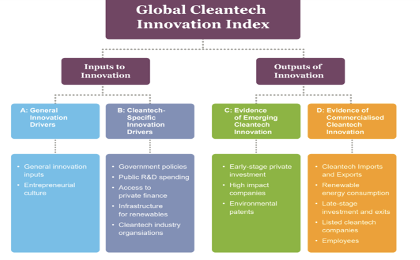News - February 10, 2021
How policy can stimulate the growth of cleantech


Written by Expert: Azhan Hasan 5 min read
Introduction
Clean technology, in short cleantech, refers to any process, product, or service that can help to reduce negative environmental impacts through methods such as significant energy efficiency improvements, the sustainable use of resources, or environmental protection activities. Cleantech includes a broad range of technologies related to recycling, renewable energy, information technology, green transportation, green chemistry, lighting, greywater, and more. In other words, cleantech products or services are those that will improve the operational performance, productivity, or efficiency while reducing costs, inputs, energy consumption, waste, or environmental pollution. This can be achieved through increased consumer, regulatory, and industry interest in clean forms of production and consumption, a trend now being seen across the world thanks to an ever-growing understanding of the importance of climate change and its impact on the natural environment.
Government policies and regulations have been recognised as key factors influencing the development of cleantech, alongside other factors such as R&D spending, financing and infrastructure. (Figure 1). As such, strong regulatory support for cleantech can be an important driver to help to encourage market adoption of clean technologies, spurring demand in the economy along with efforts to tackle any barriers to entry for the industry.

Policies for cleantech in advanced economies
Since the 1970s, environmental regulations in developed countries became much more stringent as part of a wave of new social regulation reflecting greater government willingness to intervene in the market. Many countries, particularly in Europe, established national-level environmental agencies. In the US, this expanded interest in environmental regulation was expressed in the creation of the Environmental Protection Agency in 1970 and the passage of the Clean Air Act in 1970 and the Clean Water Act in 1972. Both acts have been amended and additional regulations have targeted issues such as toxic waste, requiring firms to report toxic releases and assigning liability for cleaning up toxic waste sites. Whilst opponents argue that these regulations impose costs on business and cause firms to move elsewhere, environmental regulations have played a key role in advancing a more sustainable economy. Cleantech regulations can spur innovation by requiring changes to both how companies operate and the technologies they use cleantech regulation, not only providing economic benefits for companies (e.g. through enhanced energy efficiency) and society, but also delivering reduced environmental pollution.
Table 1: The relationship Between (Eco-)Innovation and Employment on Cleantech(Source: https://wol.iza.org/articles/impacts-of-regulation-on-eco-innovation-and-job-creation/long)
Cleantech-friendly policies have been successful in promoting the growth of renewable energy, energy-efficiency solutions and more. In doing so, this has favoured cleaner, more efficient technologies and aided the transition to a more sustainable economy. Table 2 below maps out eight policy and regulatory instruments with eight emerging economies in order to understand their significant contribution to stimulate the development of cleantech industry and drive the economic growth.
Table 2: Cleantech-Specific Innovation Drivers – Policy/Regulatory Environment for Selected Global Cleantech Innovation Programme (GCIP) Countries
(Source: The Global Cleantech Innovation Index 2017)
How can regulation help to grow cleantech? The case of the circular economy
The circular economy is gradually being seen as a way of fostering society’s move to a more resource-efficient system at the OECD, UN as well as EU level, thus improving competitiveness and capability in responding to global environmental challenge. In the last decade, at least 10 countries in Europe and Asia-Pacific, including China, Singapore, Malaysia, Taiwan and New Zealand, developed preparatory initiatives, including metrics, roadmaps and national strategies, to transition to - and eventually implement - circular economy principles. Various regulations or policies have been implemented either in advanced economies or developing economies in their efforts to promote the circular economy in all aspects of industrial landscapes. The regulations in the form of bans, quotas, taxations and extended producer responsibility (EPR) schemes have been introduced in various industries in order to support the growth of the circular economy and achieve a more efficient use of resources.
The EU has been a particularly keen advocate of policies to support the growth of cleantech in the circular economy. The European Commission presented a Circular Economy Package in 2015 with the purpose of improving cost-efficiency, achieving a better balance of current accounts, achieving more resource self-sufficiency, creating new jobs and meeting climate targets. In addition to this package, the EU’s Roadmap to a Resource Efficient and a Seventh Framework programme have contributed to the promotion of the circular economy as a national economic agenda. In 2018 the EU also launched its first regional policy framework, the ‘EU Strategy for Plastics in a Circular Economy’. The framework uses a material-specific lifecycle approach to integrate circular design, use, reuse and recycling into plastics value chains. These policy decisions have created a space for innovation in consumption and production, helping to spur the growth of efficient and sustainable solutions and processes to aid the transition to a circular economy by placing more value on resources.
Thanks to the growth of policies to support the circular economy, the transition to a more resource-efficient future is well underway. For example, the business case for adopting circularity in the chemicals industry is becoming more compelling due to a changing policy landscape, shifting demand from both consumers as well as key downstream markets, including utilities, transportation, textile and apparel, electronics, cleaning products, food and agriculture, and cosmetics and beauty. Among recent changes occurring in part due to favourable policies is the ever-growing efforts to explore bio-based materials as alternative feedstock sources, with approximately 10% of organic feedstock today being bio-based. A recent analysis from the German Government identifying 30 trends in the chemical industry up to 2030 highlights the knock-on impact that regulation and policy can have on spurring innovation and cleaner processes. These trends were analysed with regard to the underlying drivers, and assessed according to their probable impact. The results showed that many innovations in important customer industries of the chemical industry are expected, such as in the automotive, construction, and packaging industries.
Conclusion
It is very timely for governments to set ambitious policies and regulations to spur innovation and the growth of clean technology to mitigate climate change as well as to preserve the environment. Organisations like Solar Impulse Foundation can foster a long-term smart partnership with interested stakeholders in order to determine the right skills as well as resources to accelerate sustainable solutions, clean technologies, smart and futuristic thinking toward better economic decisions to support our environment.

Written by Expert: Azhan Hasan on February 10, 2021


